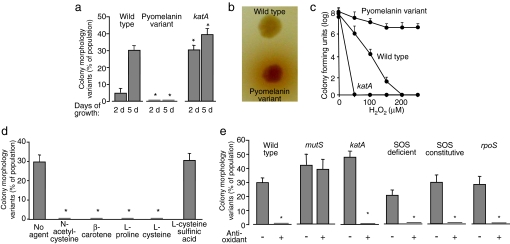Fig. 2.
Oxidative stress mediates diversity in biofilms. (a) An oxidant-resistant strain produces less diversity, and an oxidant-sensitive strain produces more diversity than WT P. aeruginosa. Graph shows the proportion of the population in WT, pyomenanin-overproducing, and katA biofilms that form colonies with variant morphologies after 2 and 5 days of growth. Data are the mean of three experiments. Error bars show SEM. *, P < 0.03 versus corresponding WT control. Bacteria from biofilms formed by the pyomenanin-overproducing strain also showed less diversity in swimming motility and pyomelanin production than WT biofilm bacteria (Fig. S3). Bacteria from katA biofilms showed more diversity in these assays (Fig. S3). (b) Photograph of colonies of the WT and pyomelanin-overproducing strain grown on indicator agar plates. The dark pigment surrounding the variant colony is pyomelanin. (c) Susceptibility of planktonically grown WT, katA, and pyomelanin-overproducing P. aeruginosa to killing by H2O2. Data are the mean of four replicates from one experiment and are representative of three others. Error bars show SEM. (d) Effect of various antioxidants on diversity in biofilms after 5 days of growth. Indicated antioxidants were added to the biofilm medium at the beginning of growth, and the proportion of bacteria with variant colony morphologies was determined. Cysteine sulfinic acid is an oxidized form of cysteine lacking antioxidant activity. Data are means of four experiments. Error bars show SEM. *, P = 0.002 versus no agent control. Addition of antioxidants also reduced diversity in swimming motility and pyomelanin production (Fig. S3). (e) The effect of hypermutability, bacterial catalase, the SOS response, and rpoS on diversity in biofilms. P. aeruginosa strains in which mutS, katA, and rpoS was inactivated, and in which the SOS response was deficient and constitutively active (see Fig. S2) were grown in biofilms for 5 days. Antioxidants decrease diversity in biofilms formed by catalase deficient P. aeruginosa, but not in biofilms formed by a hypermutable (mutS) strain. Neither the SOS response nor rpoS was required to generate colony morphology diversity in biofilms. Antioxidants eliminated the observed diversity in the SOS constitutive strain even though its SOS activity was unaffected (see Fig. S2). Similar results were seen in assays measuring diversity in swimming motility and pyomelanin production (Fig. S3). Data shown are for l-proline. In other experiments the antioxidants N-acetyl-cysteine, β-carotene, and l-cysteine had a similar effect on diversity (Fig. 2d and Fig. S3). Data are means of three experiments. Error bars show SEM. *, P < 0.002 versus the untreated control.

